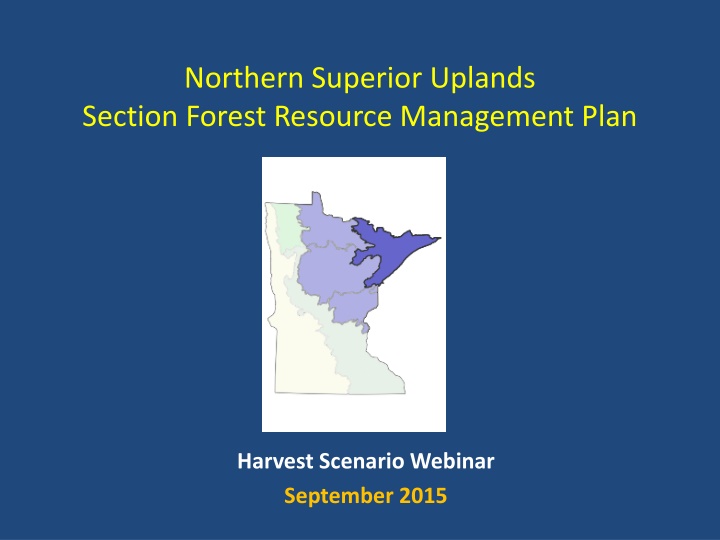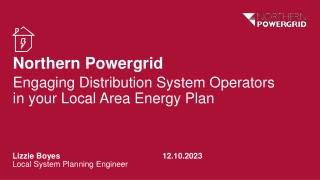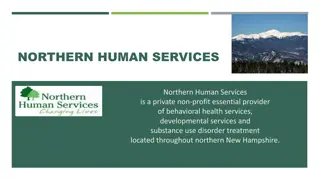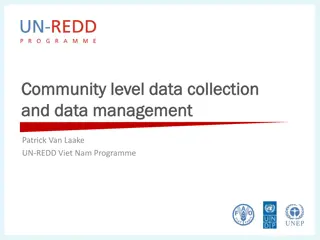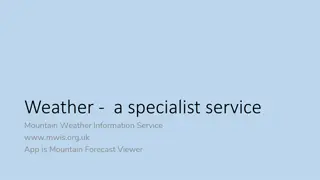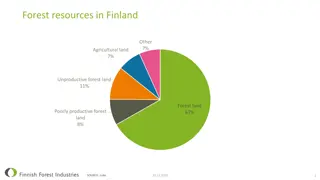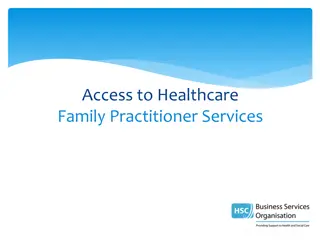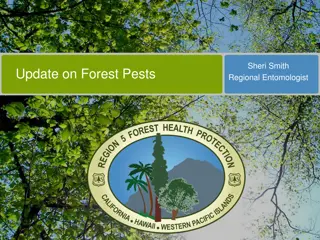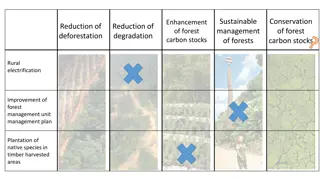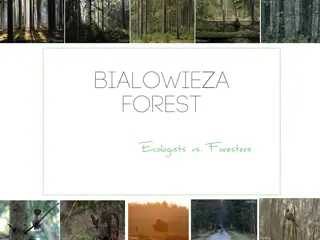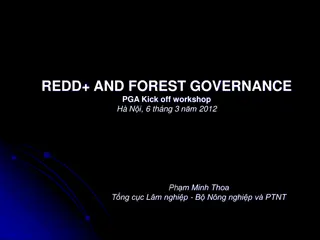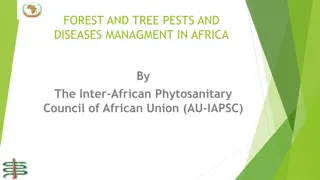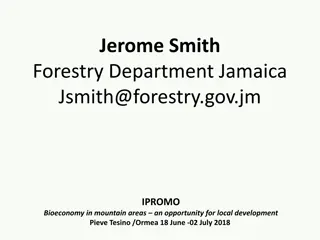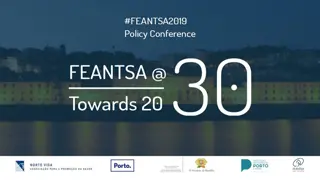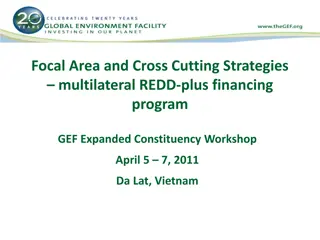Forest Resource Management Plan in Northern Superior Uplands
This presentation discusses the Forest Resource Management Plan for the Northern Superior Uplands section, highlighting the balancing of multiple values and objectives, goals of the plan, primary products, and stakeholder involvement. The plan aims to manage forestlands sustainably for habitat, ecological, economic values, with stakeholder engagement playing a crucial role in the process.
Uploaded on Sep 11, 2024 | 3 Views
Download Presentation

Please find below an Image/Link to download the presentation.
The content on the website is provided AS IS for your information and personal use only. It may not be sold, licensed, or shared on other websites without obtaining consent from the author.If you encounter any issues during the download, it is possible that the publisher has removed the file from their server.
You are allowed to download the files provided on this website for personal or commercial use, subject to the condition that they are used lawfully. All files are the property of their respective owners.
The content on the website is provided AS IS for your information and personal use only. It may not be sold, licensed, or shared on other websites without obtaining consent from the author.
E N D
Presentation Transcript
Northern Superior Uplands Section Forest Resource Management Plan Harvest Scenario Webinar September 2015
Northern Superior Uplands (NSU) 5 ECS Subsections North Shore Highlands Toimi Uplands Laurentian Uplands Nashwauk Uplands Border Lakes 4 Forestry Admin Areas 4 Wildlife Admin Areas 5 Fisheries Admin Areas 1 DNR Region (Northeast) Slide 2
Balancing Multiple Values and Objectives Stakeholder interests, statutes, and policies direct DNR to manage forestlands for multiple values, including: Habitat values Ecological /environmental values Economic values of forest products Sustainability of forest resources to support all values DNR balances these multiple interests by: Developing forest management plans (SFRMP) that incorporate DNR policies and balance multiple objectives Applying department policies and SFRMP direction in day-to-day operations (e.g., stand level management prescriptions) Slide 3
Goals of SFRMP Process Consideration of broad resource management issues affecting vegetation management. Resulting in a sustainable forest management plan that provides: Strategic forest management direction, and, A 10-year list of stands that will be examined for possible timber harvest or other management Consider forest certification standards: Forest Stewardship Council (FSC) and Sustainable Forestry Initiative (SFI) Slide 4
Primary SFRMP Products SFRMPs identify both: 1. Strategic forest management directions such as: General Direction Statements (GDS) Strategies, Desired Future Conditions (DFC), and 2. A 10-year list of stands that: Will be field visited during plan implementation Provides the best opportunity to implement the plan s strategic direction through timber harvest or other management. Slide 5
SFRMP Stakeholder Involvement Stakeholders, and the public, are invited to become involved in the SFRMP process through 3 webinars: 1. Webinar 1: Background and Introduction to SFRMPs; http://www.dnr.state.mn.us/forestry/subsection/active.html Can be viewed on line at: http://www.dnr.state.mn.us/forestry/subsection/active.html 2. Webinar 2: Alternative Harvest Scenarios 3. Webinar 3: Review of the Draft SFRMP Slide 6
Webinar 2 Review of Alternative Harvest Scenarios The DNR developed 4 harvest scenarios to explore the implications and trade-offs associated with different planning decisions This webinar describes these scenarios and their projected associated outcomes DNR is asking for stakeholder feedback on these scenarios via a series of survey questions at the end of this webinar Surveys, comments and questions will be accepted through October 17, 2015. Slide 7
Role of Harvest Schedule Modeling in SFRMP Informs planning decisions by providing a way to examine: The implications of different planning decisions through the use of timber harvest scenarios The relative sensitivity of projected outcomes to different planning decisions Optimizes the selection of the 10-year stand exam list by incorporating goals and criteria identified in the plan. Slide 8
Modeling Parameters Varied in the Harvest Scenarios The modeling parameters that we are varying across the 4 scenarios are: Even-flow Lowland Conifer Old Growth (LCOG) Cover type conversion Additional older forest These are the modeling parameters with the greatest potential effect on model outcomes and for which DNR will make decisions prior to the final stand selection model run DNR is not seeking input on other model parameters that are constant across the scenarios. Slide 9
Modeling Parameters Held Constant in All Scenarios DNR is not seeking input on established constant modeling parameters, such as: Established normal rotation ages Thinning regimes for forest types that are typically thinned or managed as uneven-aged types (e.g., red pine, northern hardwoods) Applying a standard 3% discount rate to estimate the current value of projected future timber revenues. Slide 10
Even Flow Even Flow describes the variability in estimated timber harvest over time compared to a long-term average. Range of Even Flow values explored in the 4 scenarios: Tight - 5% variation in harvest volume over time (overall and for each forest type). Produces more consistent harvest volumes decade to decade. Moderate - 20% variation in harvest volume over time (overall and for each forest type) Relaxed 40% variation in harvest volume over time (overall and for each forest type). Produces more variable harvest volumes decade to decade. See next slide for an example. Slide 11
Even Flow Example Moderate Level (20%) model allows variation up 20% projected long-term running average model allows variation down 20% Slide 12
Lowland Conifer Old Growth (LCOG) LCOG describes the amount of productive (non-stagnant) black spruce lowland and tamarack forest types reserved from being selected by the model Intended to represent possible levels of LCOG designation Range of values explored in the scenarios: 1.5% reserved, equivalent to the approximate amount of old growth forest designated on upland forest types. 5% reserved, a rough mid-point between the lower and higher amounts 10% reserved, the statewide average of productive lowland conifer forest types that have been temporarily reserved as Ecologically Important Lowland Conifer pending completion of LCOG designations. Slide 13
Cover Type Conversions Cover type conversions describe the amount of assumed or desired change from one forest type to another Range of values explored in the 4 scenarios: No Change - assumes no change from current mix of forest types on DNR lands in the landscape. Original SFRMP - continues conversion goals established in previous SFRMPs For the NSU, the model reduces the aspen and birch types by 5% each decade, with corresponding increases in jack pine, white pine, red pine, balsam fir, white spruce, and upland white cedar. Climate Change Response - conversion goals that represent a possible response to climate change effects over the 50-year projection period For NSU, the model assumes decreases in jack pine, black spruce, balsam fir, and white spruce, with corresponding gains in aspen, birch and red/white pine (in the first decade) and gains in northern hardwoods, red pine, white pine and oak in subsequent decades. Slide 14
Additional Older Forest Describes the amount of forest over normal rotation age that the model maintains on DNR lands, based on an all-ownership assessment of current forest age-class distributions. Applies to forest types managed primarily with even-aged management (aspen, birch, red pine, jack pine, black spruce, tamarack). Range of values explored in the 4 scenarios: No additional the model does not try to maintain any older forest on DNR lands included in the plan Some the model tries to maintain roughly 5%-7% older forest on DNR lands for certain forest types on certain subsections. More the model tries to maintain roughly 10-15% older forest on DNR lands for certain forest types on certain subsections. Slide 15
The Mix of Parameters in the 4 Harvest Scenarios Parameter Scenario A Scenario B Scenario C Scenario D Even Flow Tight 5% Moderate 20% Relaxed 40% Relaxed 40% LCOG 10% 5% 10% 1.5% Climate Change Response Cover type change Original SFRMP Original SFRMP No Change Add l Older Forest (if needed for certain forest types) No More Some More Additional Slide 16
Projected Outcomes Each scenario is evaluated against four projected outcomes: 1. Projected harvested volume in cords The estimated amount of timber available to harvest. Timber volume is a measurable target specified in DNR s 2015-2025 Strategic Conservation Agenda. 2. Projected stumpage revenue from harvested cords Stumpage revenue (timber sales revenue) means gross revenue from timber. DNR contributes net revenue as part of its responsibility to the Permanent School Trust Fund (Trust). Timber sales revenue provides funding to the DNR. Timber sales revenue supports local and state economies. Slide 17
Projected Outcomes (cont.) 3. Projected acreage of older forest Older forest refers to forest over normal rotation age. Only forest types managed primarily as even-aged. Older forests provide larger diameter products, habitat and aesthetic values. Projected acreage of younger forest Younger forest age varies by forest type but generally refers to forest 0 to 30 years of age. Only forest types managed primarily as even-aged. Younger forest offers habitat values and provides for future industry needs. 4. Slide 18
Projected Outcomes are for Relative Comparison Numerous factors potentially affect actual outcomes Data accuracy (e.g., inventory, yield tables) Generalized modeling assumptions Actual 10-year stand selection and adjustments (e.g., for specific spatial considerations) How spatial components of the model are applied Site-level considerations Outcomes assume all stands selected by the model will be harvested Historical evidence shows that roughly 25-30% of selected stands do not result in a timber harvest. Slide 19
Projected Outcomes Are for DNR SFRMP Lands Outcomes do not reflect other forests on the landscape, including: Forests on non-DNR lands (i.e., federal, county, private) DNR forests within State Parks, Scientific and Natural Areas, and the Boundary Waters Canoe Area Wilderness. Formally designated DNR Old Growth Other forest types managed primarily by selective harvesting (e.g., northern hardwoods, white pine, lowland hardwoods). Slide 20
Outcomes are Projected Out 50 Years The modeling scenarios project outcomes 50 years into the future. Scenario parameters are held constant over the 50- year projection period. Allows evaluation of the potential long-term implications of current planning decisions. SFRMPs are revisited every 10-years to reassess actual conditions and reconsider plan direction. Slide 21
Scenario Modeling Outcomes for NSU: Modeled Volume Available - All Species Slide 22
Example of Specific Tree Species: Modeled Volume of Aspen Slide 23
Example of Specific Tree Species: Modeled Volume of Lowland Black Spruce Slide 24
Scenario Model Outcomes for NSU: Projected Stumpage Revenue in 10 & 50 Years Slide 25
Scenario Model Outcomes for NSU: Projected Older Forest % for Lowland Conifers Slide 26
Managed Lands and Reserved Lands Upland Conifer Types Slide 27
Scenario Model Outcomes for NSU: Projected Older Forest % for Upland Conifers Slide 28
Managed Lands and Reserved Lands Upland Hardwood Types Slide 29
Scenario Model Outcomes for NSU: Projected Older Forest % for Upland Hardwoods 100% 90% 80% Percent Older Forest 70% 60% A B C D 50% 40% 30% 20% 10% 0% 0 10 20 30 40 50 Years Into the Future Slide 30
Scenario Modeling Outcomes for NSU: Projected Young Forest % for Lowland Conifers Slide 31
Scenario Model Outcomes for NSU: Projected Young Forest % for Upland Conifers Slide 32
Scenario Model Outcomes for NSU: Projected Young Forest % for Upland Hardwoods Slide 33
Modeling Scenarios Report This presentation summarizes analysis included in the report entitled Description of the Northern Superior Uplands SFRMP Modeling The Modeling Scenarios Report was prepared by DNR s Forest Modeler and is available as a technical background document (pdf file) at: http://files.dnr.state.mn.us/forestry/subsection/nsu/sfrmp-nsu-modeling.pdf Slide 34
Your Input Comprehensive forest management results from balancing many interests, including yours. Please complete the survey that follows, and comment on these parameters, scenarios and outcomes, so that your interests are considered. All comments will be evaluated and considered as the NSU planning team prepares the draft NSU SFRMP Slide 35
How to provide Your input Complete the survey no later than October 17, 2015 See survey at: https://www.surveymonkey.com/r/TK3LSK2 In addition to the survey, written comments may also be directed to: Lynn Sue Mizner, Minnesota DNR Forestry, 1200 Minnesota Avenue S., Aitkin MN 56431; or email to Lynn.Mizner@state.mn.us Slide 36
SFRMP Contact Minnesota DNR thanks you for your time and interest in the SFRMP process! For questions on the NSU SFRMP and modeling scenarios contact: Lynn Mizner 1200 Minnesota Ave., S. Aitkin, MN 56431 Phone 218-429-3022 Email to lynn.mizner@state.mn.us Slide 37
